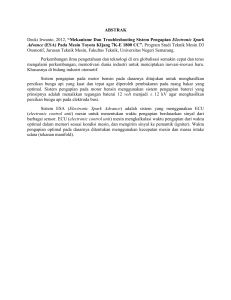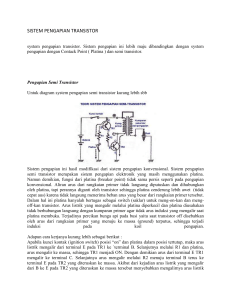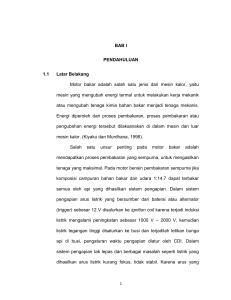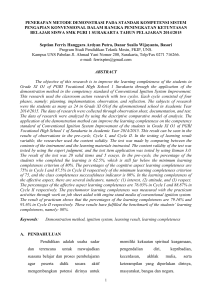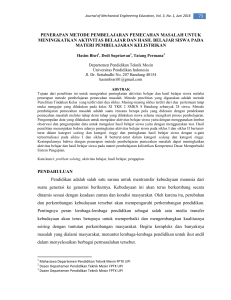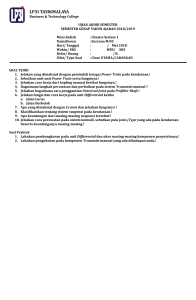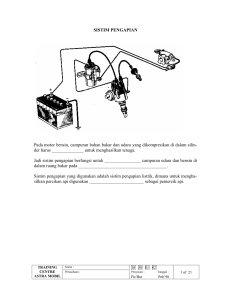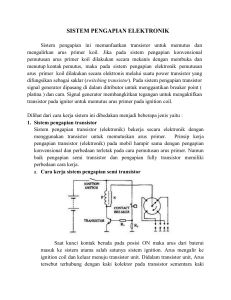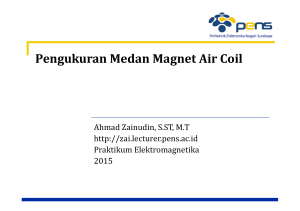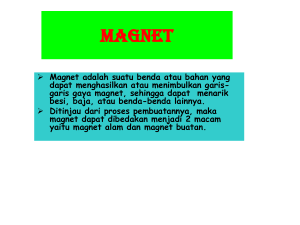Sistem Pengapian Dengan Magnet (Flywheel Generator / Magneto
advertisement
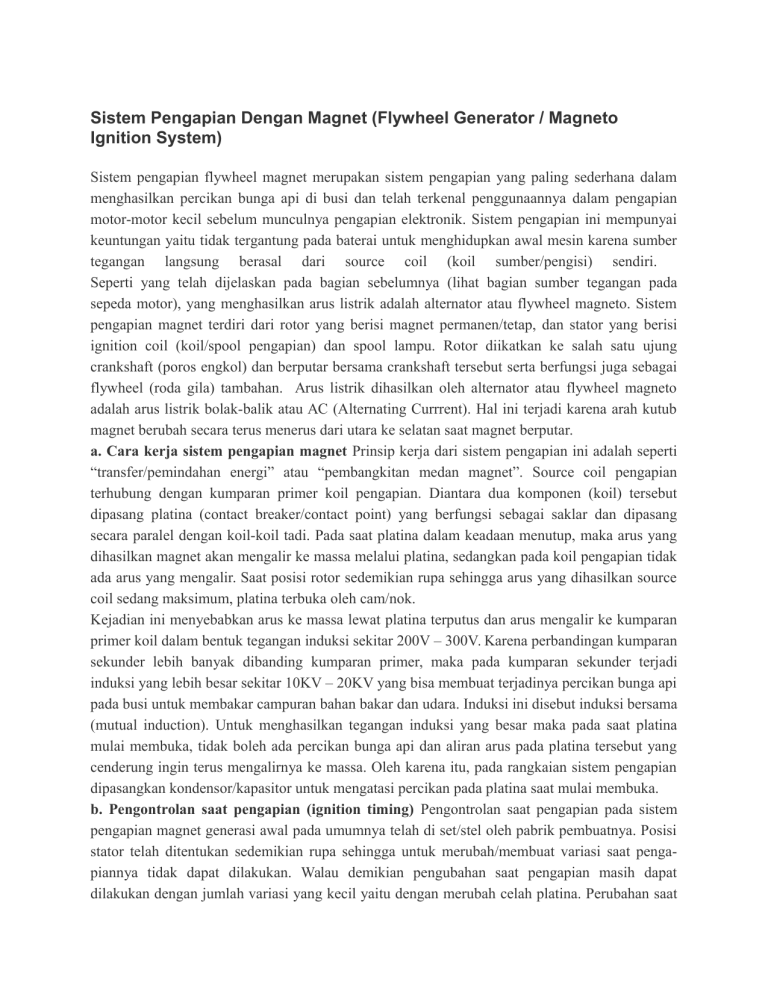
Sistem Pengapian Dengan Magnet (Flywheel Generator / Magneto Ignition System) Sistem pengapian flywheel magnet merupakan sistem pengapian yang paling sederhana dalam menghasilkan percikan bunga api di busi dan telah terkenal penggunaannya dalam pengapian motor-motor kecil sebelum munculnya pengapian elektronik. Sistem pengapian ini mempunyai keuntungan yaitu tidak tergantung pada baterai untuk menghidupkan awal mesin karena sumber tegangan langsung berasal dari source coil (koil sumber/pengisi) sendiri. Seperti yang telah dijelaskan pada bagian sebelumnya (lihat bagian sumber tegangan pada sepeda motor), yang menghasilkan arus listrik adalah alternator atau flywheel magneto. Sistem pengapian magnet terdiri dari rotor yang berisi magnet permanen/tetap, dan stator yang berisi ignition coil (koil/spool pengapian) dan spool lampu. Rotor diikatkan ke salah satu ujung crankshaft (poros engkol) dan berputar bersama crankshaft tersebut serta berfungsi juga sebagai flywheel (roda gila) tambahan. Arus listrik dihasilkan oleh alternator atau flywheel magneto adalah arus listrik bolak-balik atau AC (Alternating Currrent). Hal ini terjadi karena arah kutub magnet berubah secara terus menerus dari utara ke selatan saat magnet berputar. a. Cara kerja sistem pengapian magnet Prinsip kerja dari sistem pengapian ini adalah seperti “transfer/pemindahan energi” atau “pembangkitan medan magnet”. Source coil pengapian terhubung dengan kumparan primer koil pengapian. Diantara dua komponen (koil) tersebut dipasang platina (contact breaker/contact point) yang berfungsi sebagai saklar dan dipasang secara paralel dengan koil-koil tadi. Pada saat platina dalam keadaan menutup, maka arus yang dihasilkan magnet akan mengalir ke massa melalui platina, sedangkan pada koil pengapian tidak ada arus yang mengalir. Saat posisi rotor sedemikian rupa sehingga arus yang dihasilkan source coil sedang maksimum, platina terbuka oleh cam/nok. Kejadian ini menyebabkan arus ke massa lewat platina terputus dan arus mengalir ke kumparan primer koil dalam bentuk tegangan induksi sekitar 200V – 300V. Karena perbandingan kumparan sekunder lebih banyak dibanding kumparan primer, maka pada kumparan sekunder terjadi induksi yang lebih besar sekitar 10KV – 20KV yang bisa membuat terjadinya percikan bunga api pada busi untuk membakar campuran bahan bakar dan udara. Induksi ini disebut induksi bersama (mutual induction). Untuk menghasilkan tegangan induksi yang besar maka pada saat platina mulai membuka, tidak boleh ada percikan bunga api dan aliran arus pada platina tersebut yang cenderung ingin terus mengalirnya ke massa. Oleh karena itu, pada rangkaian sistem pengapian dipasangkan kondensor/kapasitor untuk mengatasi percikan pada platina saat mulai membuka. b. Pengontrolan saat pengapian (ignition timing) Pengontrolan saat pengapian pada sistem pengapian magnet generasi awal pada umumnya telah di set/stel oleh pabrik pembuatnya. Posisi stator telah ditentukan sedemikian rupa sehingga untuk merubah/membuat variasi saat pengapiannya tidak dapat dilakukan. Walau demikian pengubahan saat pengapian masih dapat dilakukan dengan jumlah variasi yang kecil yaitu dengan merubah celah platina. Perubahan saat pengapian yang cukup kecil tadi masih cukup untuk motor kecil dua langkah, sedangkan untuk motor yang lebih besar dan empat langkah dibutuhkan pemajuan (advance) saat pengapian yang lebih besar seiring dengan naiknya putaran mesin. Untuk mengatasinya dipasangkan unit pengatur saat pengapian otomatis atau ATU (automatic timing unit). ATU terdiri dari sebuah piringan yang di bagian tengahnya terdapat pin (pasak) yang membawa cam (nok). Cam dapat berputar pada pin, tetapi pergerakkannya dikontrol oleh dua buah pegas pemberat. Pada saat kecepatan idle dan rendah, pegas menahan cam ke posisi memundurkan (retarded) saat pengapian, Sedangkan pada saat kecepatan mesin dinaikkan, pemberat akan terlempar ke arah luar karena gaya gravitasi. saat pengapian. Hal ini akan berakibat cam berputar dan terjadi pemajuan (advance). Semakin naik putaran mesin, maka pemajuan saat pengapian pun semakin bertambah maksimum pemajuan seki-tar +20 putaran sudut crankshaft http://seringcopas.blogspot.com/2012/07/sistem-pengapian-dengan-magnet-flywheel.html 4.1 Reversibility and Irreversibility in Natural Processes We wish to characterize the ``direction'' of natural processes; there is a basic ``directionality'' in nature. We start by examining a flywheel in a fluid filled insulated enclosure as shown in Figure 4.1. Figure 4.1: Flywheel in insulated enclosure at initial and final states A question to be asked is whether we could start with state B and then let events proceed to state A? Why or why not? The first law does not prohibit this. The characteristics of state A are that the energy is in an organized form, the molecules in the flywheel have some circular motion, and we could extract some work by using the flywheel kinetic energy to lift a weight. In state B, in contrast, the energy is associated with disorganized motion on a molecular scale. The temperature of the fluid and flywheel are higher than in state A, so we could probably get some work out by using a Carnot cycle, but it would be much less than the work we could extract in state A. There is a qualitative difference between these states, which we need to be able to describe more precisely. Muddy Points Why is the ability to do work decreased in B? How do we know? (MP 4.1) Another example is a system composed of many bricks, half at a high temperature and half at a low temperature , as shown in Figure 4.2. With the bricks separated thermally, we have the ability to obtain work by running a cycle between the two temperatures. Suppose we put two bricks together. Using the first law we can write where is the ``heat capacity'' . (For solids the heat capacities (specific heats) at constant pressure and constant volume are essentially the same.) We have lost the ability to get work out of these two bricks. Figure 4.2: Bricks separated by a temperature difference Can we restore the system to the original state without contact with the outside? The answer is no. Can we restore the system to the original state with contact with the outside? The answer is yes. We could run a refrigerator to take heat out of one brick and put it into the other, but we would have to do work. We can think of the overall process involving the system (the two bricks in an insulated setting) and the surroundings (the rest of the universe) as: System is changed, Surroundings are unchanged. The composite system (system and the surroundings) is changed by putting the bricks together. The process is not reversible -- there is no way to undo the change and leave no mark on the surroundings. What is the measure of change in the surroundings? 1. Energy? This is conserved. 2. Ability to do work? This is decreased. The measurement and characterization of this type of change - of losing the ability to do work is the subject of the second law of thermodynamics.
